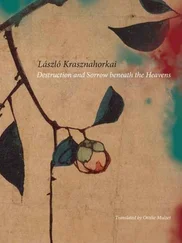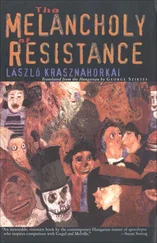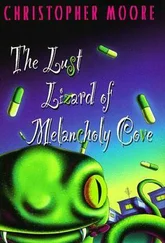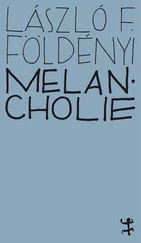As a result of that duality, the role of the mirror placed on the wall of the room grows. In the present context, we are not particularly interested in the fact that in the system of Christian symbols, the mirror — like other objects and colors — had its own signification (cleanness, clarity of vision, wisdom — but also vanity). More important than the meaning of this object is the contradiction of which the mirror forms only a part, all the more so because its allegorical function is not primary. Nor is its ornamental function, as, for example, it is in the picture of St. Eligius that Petrus Christus painted at around the same time. The world portrayed in the latter picture is so bustling, with van Eyck’s detachedness and simplicity so lacking, that the image of passersby in the street, reflected in a mirror placed on the table, merely completes and neatly expands the interior of the goldsmith’s workshop. In the Arnolfini picture, the mirror does not complete the room but hints at the instability of a world assumed to be reliable. The painter captured an exceptional moment, and while the work was in progress, he came to realize that the idea of exceptionality as a situation in life was inconceivable without its own melancholic limits. Van Eyck wished to make artistically obvious something that at the time was no longer obvious: the medieval concept of universality and permanence was also aesthetic, and the world was also an aesthetic universe, whereas in the fifteenth century aesthetics had to give up the claim of comprehensiveness. The Arnolfini Wedding refers to this changed situation: aesthetics retreated into the world of private rooms, leaving behind the prosaic world outside. The use of the mirror is thus part of an experiment, making us aware, from the very start, of resignation and melancholia, by means of which the painter includes a world invisible to the viewer in a milieu that suggests transient harmony. The position occupied by the painter is just one of innumerable possible positions, the harmonious world looks the way it does from just one single perspective — and van Eyck called on the mirror’s aid in order to point out the contradictory nature of that uniqueness in time and space. 18The mirror creates what one would nowadays call with some justice a “distancing” or “alienation” effect, since the painter is deliberately bringing to our attention the point that his viewpoint is accidental, one-off, and he therefore forces the viewer into keeping an intellectual distance while also identifying with it. Parallel to identification with the observed world, the mirror paves the way for reflection: an aesthetic gesture that gives way to thinking about the world.
A curious trap: for a second, van Eyck achieved harmony in a modern world that accepted the prosaic world into itself, but by virtue of the mirror, he warned viewers of the uniqueness and exceptionality of the spectacle and the harmony, putting a question mark next to the world. The question mark (the mirror), however, is placed within the aesthetic sphere and thus tacitly presumes a receptive community with common expectations. The hope that there is someone to whom one can appeal on account of the contingency of harmony points beyond the world that is depicted. Van Eyck called perspective into question and thereby discovered the basic paradox of bourgeois panel painting, tied up with perspectival representation, which was akin to the problematic character of those life situations that provoked melancholia in modern times. The painting not only depicts the perceived world, but also renders perceiving per se problematic. Instead of a given, ready-made object, it regards the world as a living formation displaying, microcosmos-like, the basic questions of the whole world in every phenomenon. At one and the same time, melancholia becomes the picture’s subject matter and its mode of portrayal, and for that reason this painting can be considered one of the most typical pictorial evocations of Renaissance melancholia. The world is a system of constantly unstable relations — and looking at van Eyck’s picture, one becomes convinced that painting is a kind of interpretation of life: it doesn’t merely mirror the world but has a life of its own. Painting is reality, and the world also goes on, takes shape, and changes in painting. Painting is a practical act, and our relation to painting, its reception, is the same sort of life technique — one attained on the aesthetic level — as any other activity. The process of painting, the completed painting, and its reception are re-creations of the world, each occurring at a different level. As the Arnolfini picture justifies it: reflection about painting (through the mirror) is at one and the same time an interpretation of the world; melancholic cogitation upon the world, on the other hand, if faced with art, will make that, too, problematic. If one goes back to what was said at the beginning about the Arnolfini picture and once again asks to what the sentence “Johannes de Eyck fuit hic 1434” refers, then perhaps the explanation will not seem forced. With the inserted text, van Eyck showed his relation, for one thing, to an unstably harmonious world created within the picture, signaling with the gesture of disappearing that at one moment he had been there and was part of that exceptional state. For another thing, though, this is an external reaction to the picture as a work of art: Jan van Eyck was there, and while painting a picture he mused about uniqueness, about exceptionality, about the melancholic instability of these, and about art. But maybe it is superfluous to analyze the two meanings of the inscription separately: the unity of the two is what elevates the Arnolfini wedding into an unparalleled masterpiece and exemplar of both art and melancholia.
We have seen the ambiguity of the position of melancholics of the Renaissance, their striving for absolute autonomy against both the heavenly and the earthly realm. Their melancholia was rooted in this situation, extraordinarily limited in both space and time, as well as in recognition of the situation’s exceptionality and its being bound to the moment. The Renaissance personality endeavored to create a world out of his own resources, whereas melancholics of the Renaissance realized the fallibility of that world, its condemnation to failure. They knew they were damned to a solitary creation of the world, and they knew that failure would be unbearable: even if they remained alive, neither heaven nor earth would appreciate their experiment. Renaissance melancholics set a trap for existence, but they were the ones who fell into it: being alone as they were, they had to make the world habitable and bearable by their own effort — but the world so created differed from everyone else’s world. There were as many brand-new worlds as there were personalities; since those were not in touch with one another, not only was it difficult to speak of a world that was shared by everyone (Jan van Eyck’s mirror suggests as much), but each individual world became “worldless,” point-like: rather than being universal, they were shackled by each individual’s point of view and sense experience (  ). If God is in hiding, then the world will appear differently to everyone by day, not just in their dreams, as Heraclitus thought. 19Although it is the same world in its materiality, everyone is linked with it in a different manner, and in the case of each individual, the construction of its intellectual dimensions results in a new world of his own, differing from every previous one. Nihil novum dicere —“There is nothing new to say,” says Petrarch, still in the medieval spirit. The new human image, however, was attended by a new interpretation of being. “Of all writers under the Sun, the poet is the least liar,” says Sir Philip Sidney in his apology for poetry ( The Defence of Poesy , 1583). That assertion was based on the recognition that there is room for all things in reality, and the richness of reality depends on one’s creative capabilities and imagination (which is no liar!). We encounter an extreme expression of the notion of the medieval personality in Averroës, according to whom the true subject of thinking is not the individual, the “self,” but rather a nonpersonal, substantial being whose connection with the individual ego is external and accidental (see Ernst Cassirer, The Individual and the Cosmos in Renaissance Philosophy , 127). This idea was considered extreme also in that age, but even those who attempted to defend the rights of the ego (St. Thomas Aquinas) denied that individual souls differed from one another, because of their distinct principia essentialis . An individual was part of a deeper context, body and soul, and could lay no claim to either originality or creativity. And what does the Renaissance approach, with its insistence on the autonomy of the personality, have to say about this? Nicolaus Cusanus defended just as extreme a standpoint:
). If God is in hiding, then the world will appear differently to everyone by day, not just in their dreams, as Heraclitus thought. 19Although it is the same world in its materiality, everyone is linked with it in a different manner, and in the case of each individual, the construction of its intellectual dimensions results in a new world of his own, differing from every previous one. Nihil novum dicere —“There is nothing new to say,” says Petrarch, still in the medieval spirit. The new human image, however, was attended by a new interpretation of being. “Of all writers under the Sun, the poet is the least liar,” says Sir Philip Sidney in his apology for poetry ( The Defence of Poesy , 1583). That assertion was based on the recognition that there is room for all things in reality, and the richness of reality depends on one’s creative capabilities and imagination (which is no liar!). We encounter an extreme expression of the notion of the medieval personality in Averroës, according to whom the true subject of thinking is not the individual, the “self,” but rather a nonpersonal, substantial being whose connection with the individual ego is external and accidental (see Ernst Cassirer, The Individual and the Cosmos in Renaissance Philosophy , 127). This idea was considered extreme also in that age, but even those who attempted to defend the rights of the ego (St. Thomas Aquinas) denied that individual souls differed from one another, because of their distinct principia essentialis . An individual was part of a deeper context, body and soul, and could lay no claim to either originality or creativity. And what does the Renaissance approach, with its insistence on the autonomy of the personality, have to say about this? Nicolaus Cusanus defended just as extreme a standpoint:
Читать дальше

 ). If God is in hiding, then the world will appear differently to everyone by day, not just in their dreams, as Heraclitus thought. 19Although it is the same world in its materiality, everyone is linked with it in a different manner, and in the case of each individual, the construction of its intellectual dimensions results in a new world of his own, differing from every previous one. Nihil novum dicere —“There is nothing new to say,” says Petrarch, still in the medieval spirit. The new human image, however, was attended by a new interpretation of being. “Of all writers under the Sun, the poet is the least liar,” says Sir Philip Sidney in his apology for poetry ( The Defence of Poesy , 1583). That assertion was based on the recognition that there is room for all things in reality, and the richness of reality depends on one’s creative capabilities and imagination (which is no liar!). We encounter an extreme expression of the notion of the medieval personality in Averroës, according to whom the true subject of thinking is not the individual, the “self,” but rather a nonpersonal, substantial being whose connection with the individual ego is external and accidental (see Ernst Cassirer, The Individual and the Cosmos in Renaissance Philosophy , 127). This idea was considered extreme also in that age, but even those who attempted to defend the rights of the ego (St. Thomas Aquinas) denied that individual souls differed from one another, because of their distinct principia essentialis . An individual was part of a deeper context, body and soul, and could lay no claim to either originality or creativity. And what does the Renaissance approach, with its insistence on the autonomy of the personality, have to say about this? Nicolaus Cusanus defended just as extreme a standpoint:
). If God is in hiding, then the world will appear differently to everyone by day, not just in their dreams, as Heraclitus thought. 19Although it is the same world in its materiality, everyone is linked with it in a different manner, and in the case of each individual, the construction of its intellectual dimensions results in a new world of his own, differing from every previous one. Nihil novum dicere —“There is nothing new to say,” says Petrarch, still in the medieval spirit. The new human image, however, was attended by a new interpretation of being. “Of all writers under the Sun, the poet is the least liar,” says Sir Philip Sidney in his apology for poetry ( The Defence of Poesy , 1583). That assertion was based on the recognition that there is room for all things in reality, and the richness of reality depends on one’s creative capabilities and imagination (which is no liar!). We encounter an extreme expression of the notion of the medieval personality in Averroës, according to whom the true subject of thinking is not the individual, the “self,” but rather a nonpersonal, substantial being whose connection with the individual ego is external and accidental (see Ernst Cassirer, The Individual and the Cosmos in Renaissance Philosophy , 127). This idea was considered extreme also in that age, but even those who attempted to defend the rights of the ego (St. Thomas Aquinas) denied that individual souls differed from one another, because of their distinct principia essentialis . An individual was part of a deeper context, body and soul, and could lay no claim to either originality or creativity. And what does the Renaissance approach, with its insistence on the autonomy of the personality, have to say about this? Nicolaus Cusanus defended just as extreme a standpoint:










